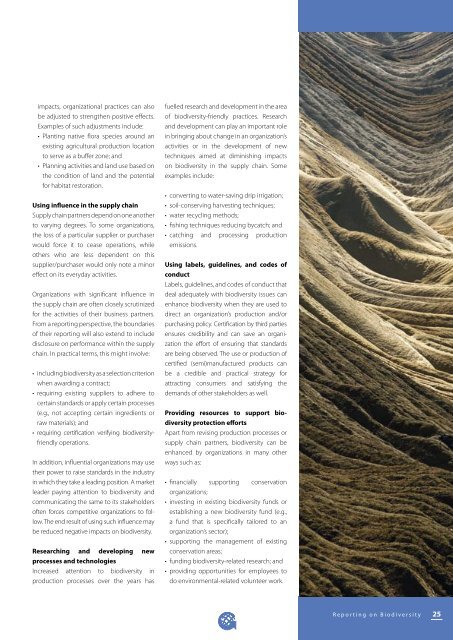Biodiversity - a GRI Reporting Resource - Global Reporting Initiative
Biodiversity - a GRI Reporting Resource - Global Reporting Initiative
Biodiversity - a GRI Reporting Resource - Global Reporting Initiative
Create successful ePaper yourself
Turn your PDF publications into a flip-book with our unique Google optimized e-Paper software.
impacts, organizational practices can also<br />
be adjusted to strengthen positive effects.<br />
Examples of such adjustments include:<br />
• Planting native flora species around an<br />
existing agricultural production location<br />
to serve as a buffer zone; and<br />
• Planning activities and land use based on<br />
the condition of land and the potential<br />
for habitat restoration.<br />
Using influence in the supply chain<br />
Supply chain partners depend on one another<br />
to varying degrees. To some organizations,<br />
the loss of a particular supplier or purchaser<br />
would force it to cease operations, while<br />
others who are less dependent on this<br />
supplier/purchaser would only note a minor<br />
effect on its everyday activities.<br />
Organizations with significant influence in<br />
the supply chain are often closely scrutinized<br />
for the activities of their business partners.<br />
From a reporting perspective, the boundaries<br />
of their reporting will also extend to include<br />
disclosure on performance within the supply<br />
chain. In practical terms, this might involve:<br />
• including biodiversity as a selection criterion<br />
when awarding a contract;<br />
• requiring existing suppliers to adhere to<br />
certain standards or apply certain processes<br />
(e.g., not accepting certain ingredients or<br />
raw materials); and<br />
• requiring certification verifying biodiversityfriendly<br />
operations.<br />
In addition, influential organizations may use<br />
their power to raise standards in the industry<br />
in which they take a leading position. A market<br />
leader paying attention to biodiversity and<br />
communicating the same to its stakeholders<br />
often forces competitive organizations to follow.<br />
The end result of using such influence may<br />
be reduced negative impacts on biodiversity.<br />
Researching and developing new<br />
processes and technologies<br />
Increased attention to biodiversity in<br />
production processes over the years has<br />
fuelled research and development in the area<br />
of biodiversity-friendly practices. Research<br />
and development can play an important role<br />
in bringing about change in an organization’s<br />
activities or in the development of new<br />
techniques aimed at diminishing impacts<br />
on biodiversity in the supply chain. Some<br />
examples include:<br />
• converting to water-saving drip irrigation;<br />
• soil-conserving harvesting techniques;<br />
• water recycling methods;<br />
• fishing techniques reducing bycatch; and<br />
• catching and processing production<br />
emissions.<br />
Using labels, guidelines, and codes of<br />
conduct<br />
Labels, guidelines, and codes of conduct that<br />
deal adequately with biodiversity issues can<br />
enhance biodiversity when they are used to<br />
direct an organization’s production and/or<br />
purchasing policy. Certification by third parties<br />
ensures credibility and can save an organization<br />
the effort of ensuring that standards<br />
are being observed. The use or production of<br />
certified (semi)manufactured products can<br />
be a credible and practical strategy for<br />
attracting consumers and satisfying the<br />
demands of other stakeholders as well.<br />
Providing resources to support biodiversity<br />
protection efforts<br />
Apart from revising production processes or<br />
supply chain partners, biodiversity can be<br />
enhanced by organizations in many other<br />
ways such as:<br />
• financially supporting conservation<br />
organizations;<br />
• investing in existing biodiversity funds or<br />
establishing a new biodiversity fund (e.g.,<br />
a fund that is specifically tailored to an<br />
organization’s sector);<br />
• supporting the management of existing<br />
conservation areas;<br />
• funding biodiversity-related research; and<br />
• providing opportunities for employees to<br />
do environmental-related volunteer work.<br />
R e p o r t i n g o n B i o d i v e r s i t y<br />
25

















